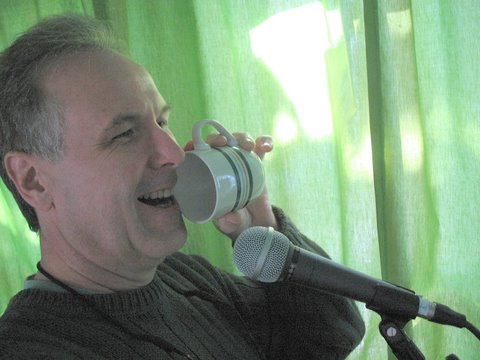

Last updated: July 8, 2023
Advice from Tony Palermo, professional radio sound effects artist
When you need to reproduce the sound of a voice coming over a
telephone, you can try the low-tech method of talking-into-a-cup, or
the high-tech EQ narrowing of a standard mic signal's bandwidth via a
computer plug-in or mixer's tone control, OR you can use what
old-time-radio engineers used--a vintage telephone wired into a
standard microphone circuit. This was the classic "Filter" microphone
used for phone voices on radio dramas from the 1930s on, as well as the
sound of The Shadow when he was invisible. For years, I've built and
used this kind of microphone for my radio productions and now I'm
selling these inexpensive Go-Filter mics for others to use too.
Here are details of several methods for getting the phone sound and
info about my mics.
People are always wanting that tinny, pinched, slightly distorted sound of a voice coming through the telephone handset as we listen to the caller talking. There are several ways to achieve this:

One easy version can be produced by taking a coffee mug, paper cup, or tall drink glass and holding it up to the side of your mouth while you speak. You have to play with the positioning a bit to get the right balance of full voice and phone-voice. Garrison Keillor's actors on Prairie Home Companion use this technique, which goes over well visually with their live audiences--it is a comedy show, after all. The sound quality only suggests the phone and our imaginations let it BE a phone caller. It's a testament to radio drama's power of suggestion.
A not too bad electronic method uses a standard microphone run through a mixer board that cuts out all frequencies under 300 Hz and over 3000 Hz--but not all mixers can cut so specifically, nor as deep as is needed. Like the paper cup method, this equalization tweaking method only suggests a voice over the phone. There are also computer "plug-in" effects out there that use this EQ technique, but they lack the slight distortion and thus, the intimacy of a real telephone. I've seen some engineers use a beat up old microphone and run it through an electric guitar distortion pedal and then EQ it severely, but that's expensive and not entirely convincing. They tend to feed back easily in live situations too.
The professional way to render this sound is to use a telephone filter mic. I make "filter" microphones out of 1960s telephone parts. They sound exactly like a phone--because they ARE phones--with both the tinny tone and slight distortion. You could do-this-yourself by cannibalizing old telephones and figure out how to wire them up and mount them in some housing, but I do that and sell them as a sideline to my radio drama work.
I've used my "Go-Filter" mics on radio drama shows for years. They don't hum, don't feedback, don't have problems with popping P's, don't pick up "bleed" from actors NOT on mic, and look so "Flash Gordon-ly" different from conventional mics that cast members rarely speak into the wrong mic by mistake. While my mic's housing is steel, the nylon face plate allows actors to produce the hang-up clicks you hear through the line by tapping on the face plate with a fingertip or clicking a tongue near the mic. The face plate is also easily wiped clean, for good hygiene. These mics get past airport security with no hassles. I travel with them all the time.
See my page on the Go-Filter mics.